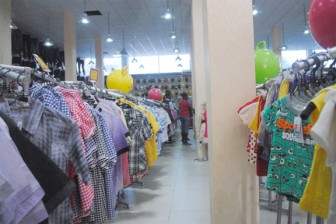Publicly, the private sector umbrella organisations in Guyana are evasive in a long-winded sort of way whenever the issue of the proliferation of Chinese merchants and the impact of their presence on the local commercial sector arises.
Perhaps it is because the political administration has already pronounced on the issue; the Chinese presence, the government says, is a reflection of the reality of free trade. Lining up behind the government has become commonplace in the private sector.

As in other instances, in private, it’s a different story. Some of the very private sector officials who provide those long-winded justifications for the presence of the Chinese in the numbers that they have come, frown on what one businessman describes as “the free-for-all” they enjoy here.
The hostility to their presence here is muted among those who would prefer that they do not remain. Not so in Brazil and Suriname, of course, where anger over what local traders have described as unfair competition has triggered tensions.
Not everyone here frowns on the presence of the Chinese merchants. Cheap consumer imports ranging from plastic kitchen utensils and children’s toys to party dresses go down well in a country where wages are low and American-made household items and locally made dresses can cost much more. There is always a curiosity about what the Chinese have to offer though, frequently, enthusiasm for their goods only last as long as the goods themselves, which in many cases, is by no means a long time. The problem is, of course, that those who feel the edges of their dollar, often find the Chinese prices irresistible.
The problem arises when the working girl embraces the Chinese retailer in preference to a seamstress with whom she may have had an extended relationship; when special events and seasons cease to bring windfalls to reputable dressmakers and when the more popular brands of footwear are set aside for the cheaper Chinese products. It is the multiplication of the effect of the Chinese trader on several areas of commercial activity that is beginning to cause some degree of worry.
These days, it is not uncommon to discover that a long-established retail trader has suddenly and inexplicably closed shop, only to be replaced at those premises by a newly-arrived Chinese. This newspaper has spoken with a few potential small business owners who claim that they have been “muscled out of the market” by the Chinese.
One local businesswoman told this newspaper that with the arrival of the Chinese “the going rate” for rentals is around US$1,000 per month for a 10 x 30 trading space. The phenomenon, she says, has given rise to the emergence of unscrupulous landlords who have taken to gouging long-standing tenants by threatening to replace them with Chinese.
Nor is it any secret, the businesswoman told Stabroek Business that Chinese are given first preference by urban landlords. A city businessman whose family has been in the retail trade for more than half a century told Stabroek Business that he is under pressure to pack it in by a Chinese trading group that has promised to make it worth his while; so to speak. He is still trading.
The real leverage which the urban Chinese traders enjoy reposes in their competitive pricing. What this newspaper found was that urban low-income consumers acknowledge that while some Chinese products may be inferior their prices “cater to the poor man’s pocket”.
For the moment at least, local boutique operators appear confident that their quality clothing can withstand the cheap Chinese imports, though one downtown operator expressed a measure of discomfort over the fact that less than two weeks ago a new Chinese trader opened a shop next door to her business premises.
Local seamstresses too, while not yet displaying outward signs of worry over the proliferation of Chinese clothing retailers have said that they are aware of the phenomenon. One seamstress who says she sews for “high end” clients believes that very soon the Chinese could be taking away “major business” from the small operators. “We must bear in mind that more people are looking for the cheaper options and the Chinese definitely provide a cheaper option,” she said.
Vendors appear to have little to complain about. This week on Regent Street, a number of itinerant vendors were talking up the Chinese merchants. One of them put it simply: “Vendors don’t produce anything. We sell what is on the market, Chinese or whatever…”
Visits to several urban Chinese trading establishments reveal that they continue to offer a bewildering array of commodities and that they are encroaching increasingly into sectors which they had hitherto not been focusing on.
One such area is women’s cosmetics, notably the multi-million-dollar artificial hair industry. On the one hand some local beauticians say the Chinese products are unlikely to catch on with the fashion-conscious local market. Others differ, pointing out, that low-cost weaves and wigs offer more low-income women an opportunity to indulge in “looking good”.
The local private sector remains more or less mum on the matter, refusing to be critical of the growing influx of Chinese traders but acknowledging, often seemingly grudgingly, that efforts should be made to protect some of the more vulnerable small business sectors. Given the fact that some of the country’s largest importers of goods ranging from computers to artificial flowers are doing big business with the Chinese one really cannot expect them to run down the invading Asian merchants.




